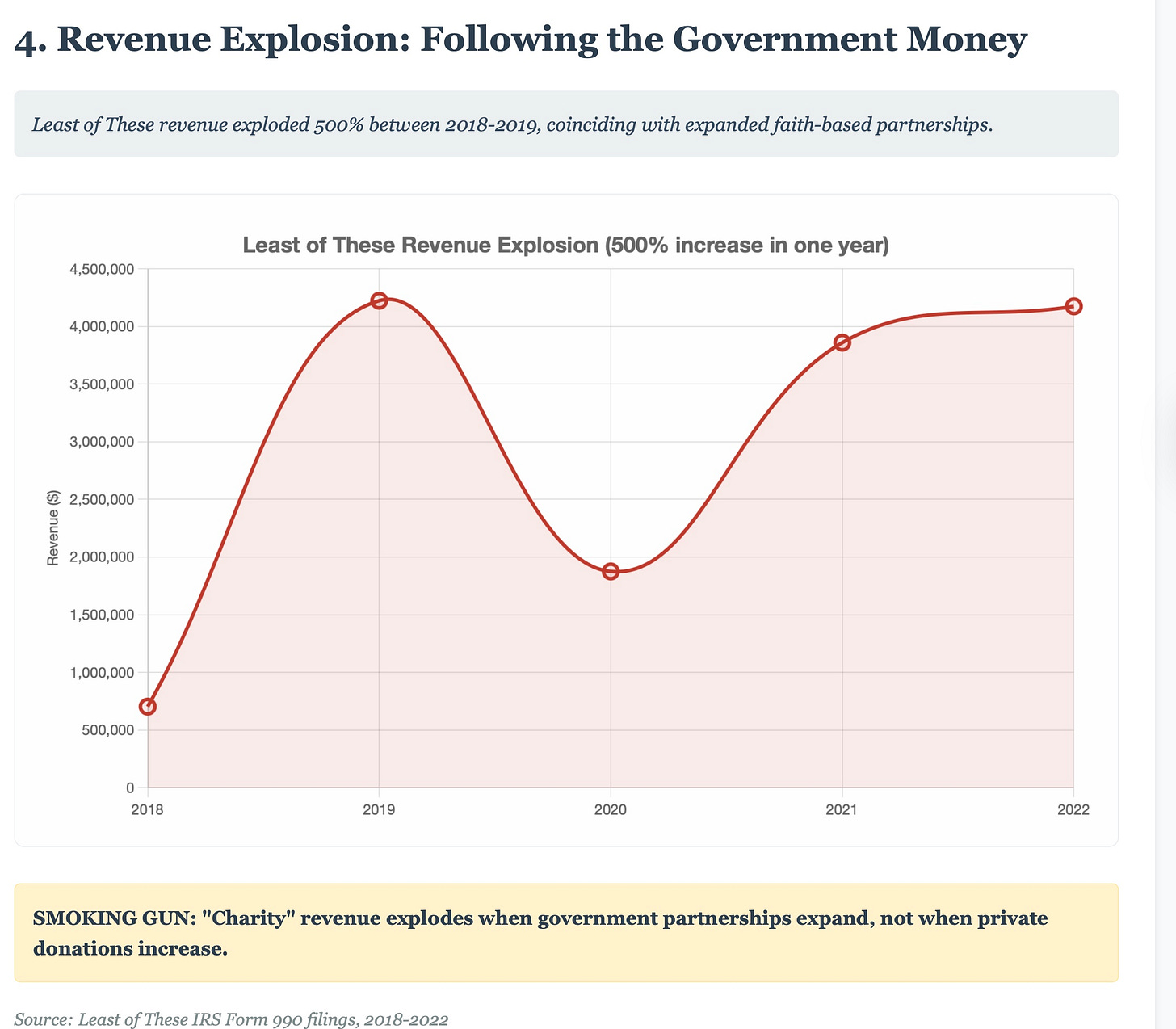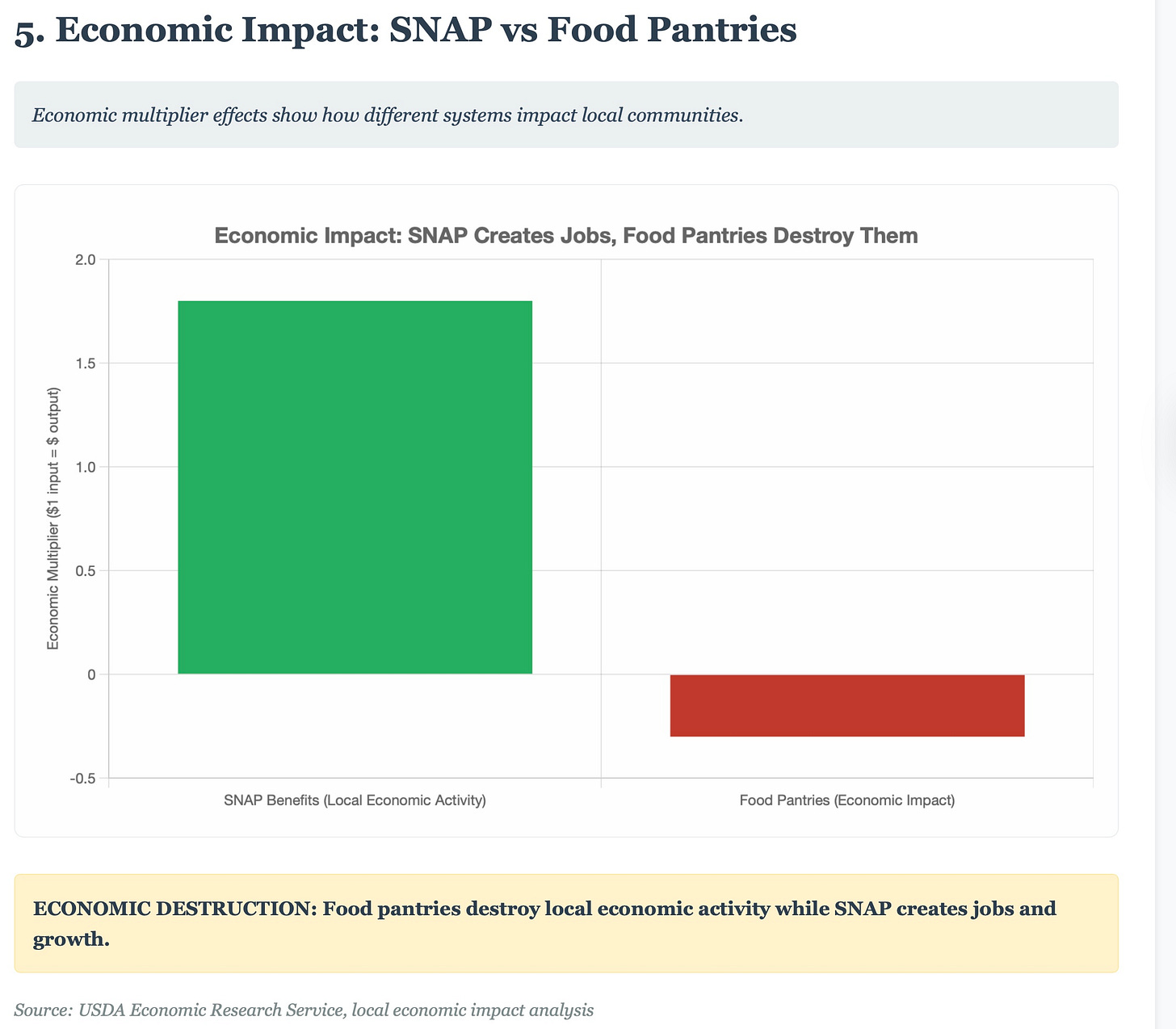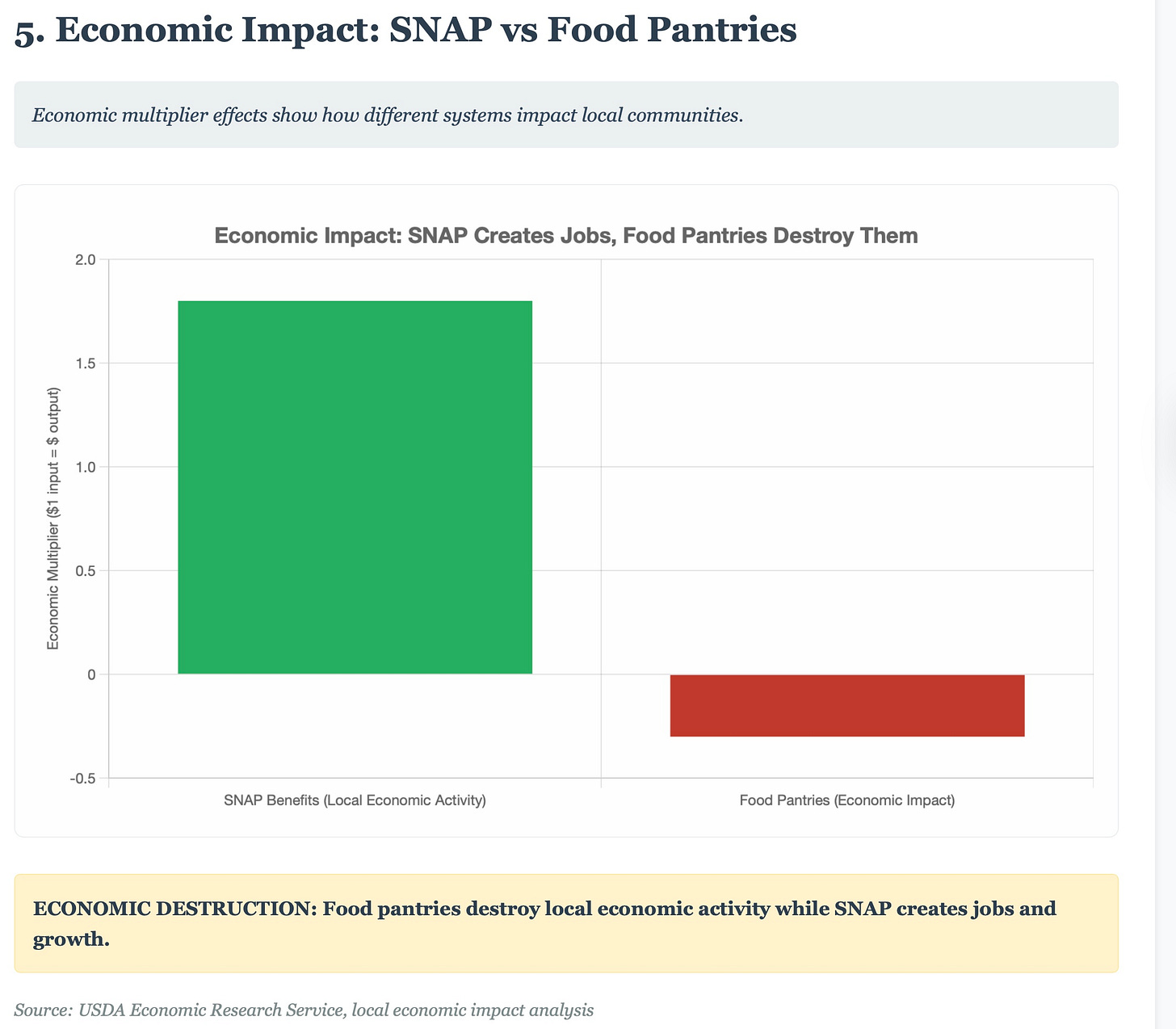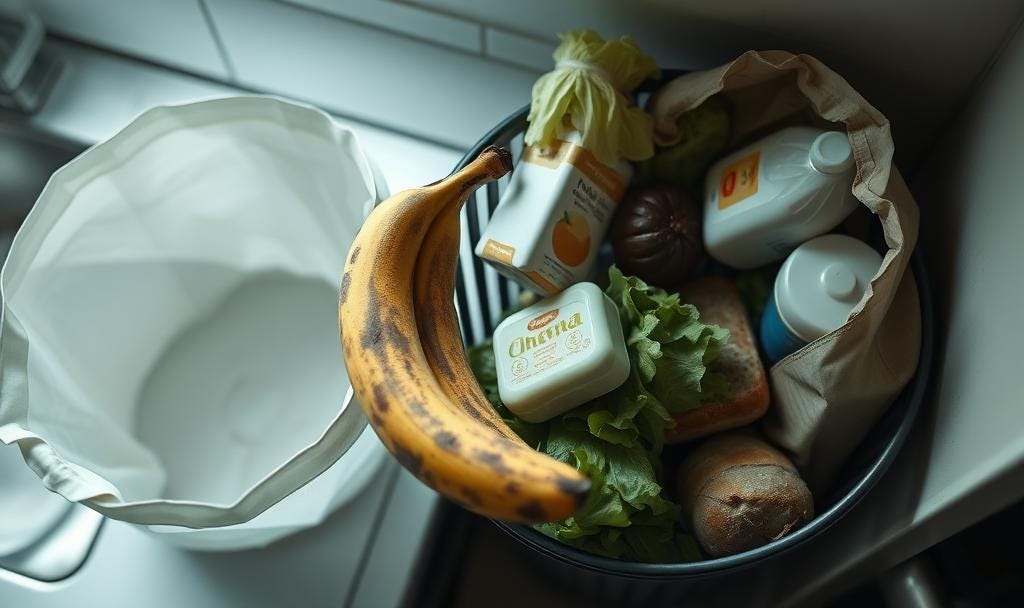I can't tell you how many times I came home from the Least of These food pantry in Christian County, Missouri, only to throw away spoiled food. Rotten fruit, expired cartons, meat that had turned—all donated with the best of intentions by volunteers who never see what happens to their carefully packed bags just days later.
My family's crisis journey through both systems—SNAP in 1999 and food pantries twenty years later—reveals how much worse things have become for working families in crisis. We didn't like having an EBT card back then. It was demeaning, and we worked hard to get off Food Stamps because the system creates too much temptation not to work diligently toward independence.
But when I almost died years later, I didn't recover well, and suffered ongoing medical complications that made holding a regular job impossible, and we became working poor. We'd lost half our income but could still pay our bills—we just had no money left for groceries. Our church offered no help. The world had changed since we'd last needed assistance.
The food pantry system that emerged was somehow worse than the DFS offices we'd experienced in 1999. The process was impersonal and dehumanizing, and it was also embarrassing. Then COVID hit, and we were forced to line up in our cars with as little human contact as if we were dangerous. Even after sanity returned, the drive-through cattle system remained. We were pushed through, given our feed bag, and sent back onto the road.
Meanwhile, when we'd received SNAP benefits decades earlier, despite the stigma, we never had to worry about spoiled food. We could choose fresh groceries with dignity, supporting local businesses and keeping our tax dollars circulating in the community.
But here's what those well-meaning volunteers don't know: they're not just packing charity. They're providing free labor for a government-funded operation that enriches corporations while impoverishing the very communities they're trying to serve.
Following the Money: The Numbers Don't Lie
Least of These, Inc. claims to serve 1,400 Christian County families monthly through its food pantry operations. According to their 2022 IRS Form 990, their revenue increased from $702,610 in 2018 to $4,174,586 in 2022—a nearly 500% rise that coincides perfectly with the expansion of government partnerships in social services.

When contacted for comment, Least of These reveals the sophisticated funding pipeline that obscures government involvement. While claiming to receive no "direct" government funding, they acknowledge receiving TEFAP (The Emergency Food Assistance Program) and CSFP (Commodity Supplemental Food Program) items—both federal programs—through Ozarks Food Harvest. They also receive funding through "grants," though they declined to specify whether these grants originate from government sources.
Since Michele confirmed that TEFAP and CSFP commodities flow through Ozarks Food Harvest, and OFH now represents 53% of Least of These distribution, over half of their food distribution consists of federal commodities.
This makes her claim of receiving "no direct government funding" possibly misleading. When 53% of your operation depends on federal programs, you are fundamentally a government food distribution program operating under the cover of private charity.
This layered structure isn't accidental—it's the deliberate design of modern "faith-based partnerships" that allow organizations to claim private charity status while operating on taxpayer-funded resources. The food flows from federal programs through regional food banks to local "charities," creating the illusion of private generosity while maintaining government dependency.
This pipeline structure originated with President Bush's Faith-Based Initiative and has been expanded under every subsequent administration. Rather than direct government welfare spending, the system now operates through intermediary organizations—regional food banks like Ozarks Food Harvest that receive federal commodities and distribute them to local "private" charities. This allows politicians to claim reduced government spending while maintaining the same taxpayer funding, just hidden through multiple organizational layers.
The Ozarks Food Harvest Pipeline: Following the Money
Michele Pierce's claimed unfamiliarity with Ozarks Food Harvest's funding sources reveals how the system operates through compartmentalized knowledge. TEFAP accounts for nearly 25% of the food Ozarks Food Harvest distributes to its network of 270 faith-based and community charities, with almost one out of every four meals distributed by Ozarks Food Harvest provided through federal nutrition programs.
Pierce's primary supplier—the organization she says she knows little about financially—is actually a quarter government-funded operation distributing federal commodities. When recent federal cuts eliminated $3 million worth of TEFAP food, Ozarks Food Harvest acknowledged this represented a substantial portion of their approximately $12 million annual food budget.
The Federal Dependency Revealed
The scale of government dependency becomes clear when examining the numbers Pierce provided. With OFH supplying 53% of Least of These' food distribution (901,066 pounds annually), and 25% of OFH's distribution consisting of federal TEFAP commodities, approximately 225,000 pounds of federal food flows through Least of These annually, roughly 13% of their total distribution.
Federal records confirm Ozarks Food Harvest has directly received federal infrastructure grants, including a $100,401 TEFAP General Infrastructure Grant in 2011 to purchase backup generators and warehouse equipment. This direct federal funding relationship demonstrates the extensive government involvement in the food distribution system that Pierce may not be aware of.
The Compartmentalized Knowledge System
Pierce's unfamiliarity with OFH's funding sources, given that she depends on them for 53% of her operation's food supply, illustrates how the system functions through deliberate compartmentalization. Each layer operates with limited knowledge of the other layers, allowing each to maintain its role while the overall government funding pipeline remains obscured.
The financial pipeline operates as follows: federal TEFAP programs provide approximately $3 million annually to Ozarks Food Harvest, which then distributes these taxpayer-funded commodities to organizations like Least of These, which can truthfully claim to receive "no direct government funding". At the same time, their staff remain unaware of the government funding flowing through their supply chain.
This isn't necessarily deception—it's a system designed to allow well-meaning people to participate in good faith. At the same time, the overall structure maintains the appearance of private charity funded primarily by taxpayer dollars.
When "Private Charity" Means Taxpayer-Funded
When contacted about these discrepancies, Michele Pierce, Director of Client Services, confirmed that while they receive no "direct" government funding, they do receive federal TEFAP and CSFP commodities through Ozarks Food Harvest. When pressed for specifics about grant sources, Pierce claimed they currently receive no government grants, although they did receive federal funds in 2020. She also claimed no knowledge about Ozarks Food Harvest's funding sources, while acknowledging a "substantial" dependency on their supplies.
Pierce emphasized their food safety training and procedures, distinguishing between food safety (meeting regulatory standards) and food quality (freshness and desirability).
While families may receive food that won't harm them, the question remains whether taxpayer-funded charity should distribute expired corporate waste when the same money could be used to provide fresh food choices through transparent government programs.
"We do not receive any direct local, state or federal government funding... We do receive a few items in small quantities of TEFAP foods when we order food from Ozarks Food Harvest... We also receive 190 CSFP senior boxes... our funding comes from donations from the public and grants."
—Michele Pierce, Least of These Director of Client Services
This response perfectly illustrates how the Spanish Prisoner operates: technically truthful statements that obscure the government funding pipeline flowing through every level of the operation. It also shows how people are unaware the system they operate in appears legitimate, but is a government con.
The organization's response reveals the cognitive dissonance inherent in the system: well-meaning people genuinely trying to help families while participating in a structure that benefits corporations and obscures government spending at the expense of both community economic development and recipient dignity.
The $2.2 Million Government Subsidy Hidden in Plain Sight
If OFH supplies 53% of Least of These' $4.17 million operation, that represents approximately $2.2 million in annual value. Since Michele confirmed that this includes federal TEFAP and CSFP commodities, over half of their reported revenue consists of taxpayer-funded food commodities flowing through intermediaries.
This explains the "complex math" Michele referenced when asked about efficiency. When you're distributing $2.2 million worth of taxpayer-funded commodities while claiming to be privately funded, the accounting needs to become complex to legitimize the reality.
The Follow-Up: When Questions Get Uncomfortable
When pressed for specifics about funding sources and operational details, Michele Pierce's second response revealed even more about how this system operates through deliberate opacity.
Asked about grant sources: "We do not currently receive any government grants. We received some federal funds during the 2020 epidemic, but not since then."
Asked about Ozarks Food Harvest dependency: "I don't have an average as that would change every month. I would feel comfortable saying a substantial amount, which includes both free product and items we purchase from them."
In a follow-up email, Michele Pierce provided specific numbers revealing that Ozarks Food Harvest supplies 53% of all food distributed by Least of These—901,066 pounds out of 1.7 million total pounds in their current fiscal year.
Asked about OFH's government funding: "I have no idea of OFH's funding sources. They would be your best bet to answer that."
Asked about the $4.17 million efficiency: "Our financials include in-kind donations, so they don't show a direct dollar received/dollar spent amount. The math is more complex than that."
Asked about food quality tracking: "We track food discarded before distribution due to spoilage by pound. We do not track spoilage after clients have received food, as that is not something under our control."
The Majority Supplier She Claims to Know Nothing About
In a third email, Michele Pierce revealed that OFH supplies 53% of all food distributed by Least of These. This means the organization OFH is her majority supplier.
The numbers are staggering:
811,310 pounds donated from OFH
89,756 pounds purchased from OFH
901,066 total pounds from OFH (53% of all distribution)
For context, this means this supplier provides over half of everything LOT distributes to families.
Quality Control
LOT tracks spoilage "by pound" before distribution—a questionable metric that reveals nothing about the recipient's experience. LOT doesn't track post-distribution spoilage because it's "not under [their] control."
This reveals the system's priorities: regulatory compliance over recipient dignity, cost management over food quality, and organizational protection over client feedback.
LOT’s response to questions about food quality tracking confirms what families experience: complaints are discouraged, concerns are minimized, and recipient feedback is not sought out. LOT stated that complaints are "too few and far between," which contradicts the lived experience of families watching portions shrink and quality decline month after month.
The organization tracks spoilage "by pound" before distribution—a metric designed to satisfy regulators, rather than improve the recipient's experience. They explicitly refuse to track post-distribution quality because it's "not under their control." This perfectly captures the system's priorities: once the food leaves their building, recipient dignity becomes irrelevant.
The Real Cost of "Free" Food
Here's the devastating math: The Least of These spends $4.17 million annually to provide what amounts to approximately $20.67 per family per month in food assistance. If that same money went directly to SNAP benefits at $250 per family per month, it could provide complete food security for 1,391 families for an entire year, nearly the same number they currently serve with spoiled leftovers.

The difference? With SNAP, families had some dignity, choice, and access to fresh food. With food pantries, they get Walmart's near-expired waste that often spoils before it can be consumed.
However, the damage extends beyond mere inefficiency. Every family that obtains its food from pantries instead of purchasing it represents lost sales for local grocery stores, reduced sales tax revenue for municipalities, and eliminated retail jobs in communities that desperately need economic activity.

The Government Funding Pipeline Exposed
When Least of These claims no "direct" government funding, they're technically correct—and that's precisely the problem. The federal government doesn't write checks directly to local food pantries. Instead, it creates a laundering system:
Step 1: Federal agencies fund programs like TEFAP and CSFP with taxpayer money.
Step 2: Regional food banks like Ozarks Food Harvest receive and distribute these federal commodities
Step 3: Local "charities" like Least of These receive government food while maintaining their private charity status
Step 4: Volunteers provide free labor to distribute taxpayer-funded food, believing they're engaged in private charity
The genius of this system lies in its plausible deniability. Ozarks Food Harvest can claim they're helping local charities. Least of These can claim they receive no direct government funding. Politicians can claim they're supporting "faith-based solutions" rather than expanding welfare.
Meanwhile, taxpayers fund the entire operation without transparency, accountability, or the efficiency they'd demand from direct government programs.
Walmart's Perfect Scam
The beauty of this system—for corporations like Walmart—is its triple benefit structure:
First, Walmart avoids paying higher wages because its employees can receive food assistance through pantries instead of demanding salaries that would allow them to afford groceries.
Second, Walmart receives massive tax write-offs by donating its expired and near-expired inventory to food pantries at full retail value, while simultaneously avoiding disposal costs for waste that would otherwise be sent to landfills.
Third, as food pantry operations reduce grocery sales volume, Walmart justifies eliminating cashier positions and converting to self-checkout systems, further reducing labor costs. At the same time, taxpayers fund the unemployment and food assistance for displaced workers.
The beauty of the food bank pipeline is that Walmart benefits even when they don't donate directly to local pantries. When Walmart donates expired inventory to regional food banks like Ozarks Food Harvest, they still receive tax write-offs at full retail value. The food then gets distributed to multiple local charities, multiplying the public relations benefit while the corporation avoids disposal costs.
Local pantries like Least of These become unwitting participants in this corporate welfare scheme, believing they're receiving "donated" food when they're actually distributing taxpayer-funded commodities that generate tax benefits for the corporations that "donated" them.
It's corporate welfare disguised as Christian charity.
The Ignorance Economy
The most revealing aspect of Pierce's responses is her claimed ignorance about fundamental aspects of the operation she manages. She doesn't know:
The percentage of food that comes from their primary supplier
The funding sources of that primary supplier
How their $4.17 million budget translates to family assistance
The actual rate of recipient complaints about food quality
This isn't incompetence—it's strategic ignorance. Each layer of the system is designed to operate independently of the other layers, creating plausible deniability in the event of questioning.
Pierce can truthfully claim she doesn’t know about OFH's government funding while distributing federal commodities. I believe Pierce and other staff at LOT are people trying to help members of the community.
OFH can claim they're just helping local charities while distributing taxpayer-funded food. Federal agencies can claim they're supporting community partnerships while funding corporate welfare.
The system works precisely because each participant can honestly claim to be unaware of the other participants. It’s a complicated double-blind espionage system where everyone is an agent, but no one knows who will reveal the information.
Real Charity vs. Government-Funded Theater
I'm a capitalist who believes in genuine charity—the kind that builds communities rather than exploiting them. The Bible instructs churches to prioritize caring for their members, fostering authentic relationships, and promoting accountability. Instead, modern churches send their members to pack bags for strangers at government-funded warehouses, never learning who in their congregation is struggling with job loss, medical bills, or economic hardship.
Galatians 6:10 (ESV): "So then, as we have opportunity, let us do good to everyone, and especially to those who are of the household of faith."
1 Timothy 5:8: "But if anyone does not provide for his relatives, and especially for members of his household, he has denied the faith and is worse than an unbeliever."
Acts 6:1-3 (the selection of deacons): Shows the early church organizing systematic care specifically for their own widows and members in need.
2 Corinthians 8:13-14: Paul describes churches sharing with other churches, but the emphasis is on known communities helping known communities, not anonymous charity.
1 John 3:17: "But if anyone has the world's goods and sees his brother in need, yet closes his heart against him, how does God's love abide in him?" (The "brother" here refers to fellow believers)
Real charity would mean churches knowing their people well enough to help before a crisis hits. The message was always clear when I spoke to a pastor. “We don’t do that here. Why don’t you reach out to…” It would mean creating businesses that provide actual jobs for community members rather than volunteer positions that subsidize corporate waste disposal. It would mean building economic opportunity instead of managing poverty.
But creating jobs requires risk, investment, and long-term commitment. Government-funded food pantries require only showing up to pack bags and feeling good about "serving." One builds sustainable communities; the other builds sustainable dependency while enriching those who manage it.
Destroying Communities Through "Compassion"
This isn't just about waste—it's about economic destruction disguised as Christian compassion. When churches redirect their volunteer energy toward government-funded food pantries, they're not building their communities. They're participating in their economic dismantling.
Those volunteer hours could be spent supporting local businesses, creating actual economic opportunity, or advocating for education or skills that would eliminate the need for food assistance. Instead, they're being harvested to provide free labor for a system that benefits large corporations at the expense of local economic development.

The ripple effects compound: reduced grocery sales lead to store closures, which in turn eliminate jobs, creating more demand for food assistance. As a result, communities become increasingly dependent on charity systems that offer no path to economic independence.
The Bipartisan Betrayal
This system represents a bipartisan betrayal of both conservative and progressive values. Republicans abandoned free market principles and fiscal responsibility. Democrats abandoned transparent social programs and worker protections. Both parties found it easier to hide welfare spending through "faith-based partnerships" than to address the root causes of economic inequality.
Whether it's Bush's "compassionate conservatism," Obama's community partnerships, or Biden's faith-based initiatives, the result is the same: government money flows to nonprofits and corporations. At the same time, families receive less help and communities suffer greater economic damage.
Beyond All Government Dependency: Demanding Real Solutions
I'm not advocating for SNAP as the solution—we hated being on it and fought to get off by putting ourselves through school. Both systems rob families of dignity and create dependency. The real solution lies in economic systems that foster skills and education, support local businesses, and create genuine economic opportunities rather than any form of managed dependency.
However, the modern food pantry system represents a step backward even from the flawed SNAP program. At least SNAP was transparent about being government assistance and allowed families to purchase fresh food. The pantry system hides government funding while delivering spoiled goods through a dehumanizing process that treats families like cattle.
We are spending $4.17 million on food assistance in Christian County, and it’s government-funded. In that case, we should demand transparency about the source of that money, its efficient use, and the dignity afforded to the families who receive it.
We should demand that Walmart pay wages that enable its employees to afford fresh food, rather than relying on taxpayer-subsidized charity. We should demand that government partnerships with religious organizations be disclosed and made accountable. We should demand that our tax dollars strengthen local economies rather than enrich corporate bottom lines.
Most importantly, we should demand that our churches stop providing free labor for systems that contradict the very values they claim to promote.
The Choice Before Us
The question facing Christian County—and communities across Missouri—is simple: Do we want economic systems that create opportunity and dignity, or do we want charity systems that manage poverty while enriching those who profit from it?
Churches often fail to recognize who in their community is suffering, and as a result, they are free to spend their money on larger and more elaborate buildings and programs rather than on the needy. The government is subsidizing Christian Charity.
Do we want churches focused on building strong communities, or do we want them serving as an unpaid workforce for corporate welfare schemes?
Do we want transparency in how our tax dollars are spent, or do we want government funding hidden behind nonprofit facades?
The current system isn't compassionate—it's exploitative. It doesn't serve the poor—it serves those who profit from poverty. And it doesn't strengthen communities—it systematically dismantles them while calling it charity.
It's time to choose economic justice over managed dependency, transparency over hidden subsidies, and genuine community development over corporate welfare disguised as faith.
The volunteers at Least of These have good hearts and genuine intentions. I think the employees also have good hearts. You don’t go to work at a food pantry to become an evil corporate stooge. They deserve to know what their labor is truly supporting, where the funding originates, and how their efforts impact the community they aim to serve.
They deserve better than being unwitting participants in a system that destroys what they're trying to build.
Bush called it compassionate conservatism. What he created was compassionate vampirism. Our best and most caring people are divorced from the church and sent into a corporate hellscape funded by the government to misuse their energy, talent, and compassion purposely. The results for those in need are the lack of Christ, as Pierce said, they don’t proselytize. What a clinical, theological way of saying they don’t share Christ.
Our churches build monuments to themselves now that they don’t have to feed the hungry, clothe the naked, or visit the sick. Bush, Obama, and Biden have turned our people against us, inverting the gospel and charity into a secular activity devoid of Christ’s redemption and resurrection. It is ironic to call their corporation Least of These when the beatitudes seem to be the furthest thing from their minds.
This investigation is ongoing. Least of These graciously responded to questions. I appreciate their time, though the article is critical of the system they operate within. Walmart has not responded to requests for comment.
Sources:
Least of These, Inc. Form 990 (2022), Internal Revenue Service
Missouri TANF Spending Report, Center on Budget and Policy Priorities
Personal experience as a food pantry recipient and SNAP recipient, Christian County, Missouri
Economic impact studies on SNAP multiplier effects, USDA Economic Research Service





